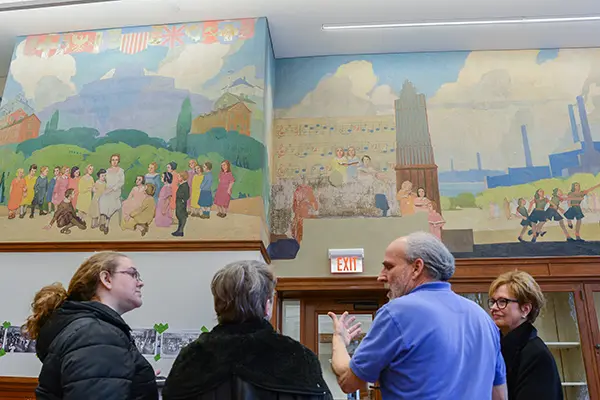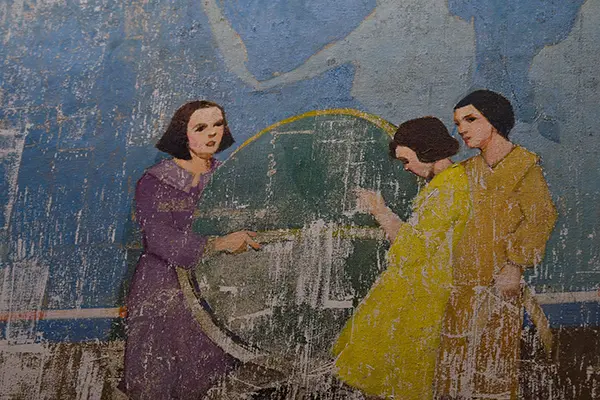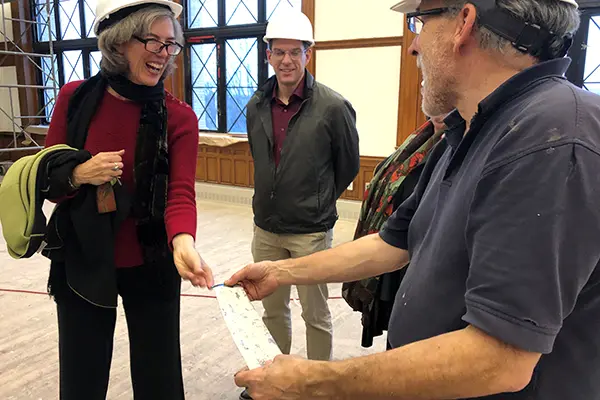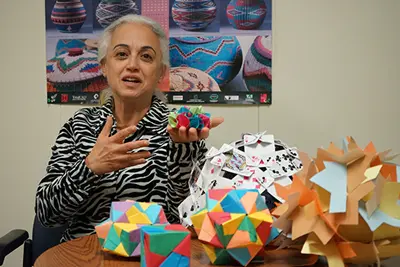WPA-era Paintings Restored as Part of Building Renovation and Expansion
 Image by Tory Wesnofske
Image by Tory Wesnofske
02/06/2020
By Beth Brosnan
Coburn Hall, UMass Lowell’s oldest and most iconic building, is filled with history. But for decades, one of its most colorful chapters has been hidden from sight — covered by a thick curtain and two coats of paint.
No longer.
As part of Coburn’s $47 million top-to-bottom renovation and expansion, art conservators have pulled back that curtain, stripped away the paint and revealed the WPA-era murals that cover an entire wall of the building’s former ballroom.
Commissioned during the Great Depression, the 10-foot-by-64-foot murals were “the pride and joy” of what was then State Teachers College at Lowell (LTC), says Marie Frank, the art history professor who championed their restoration: “They received extensive coverage in the local press because they offered an uplifting story about the college’s mission and the city’s heritage.”
In 1934, Principal Clarence Weed and art instructor DeMerritte Hiscoe hired three rising artists — Carroll Bill, Richard V. Ellery and Elmer W. Green Jr. — to collaborate on murals celebrating education in Lowell.
Painted on large canvases that were then glued to the ballroom wall, the brightly colored murals depict students at work and play against a backdrop of local landmarks like the Lowell mills and area schools where LTC graduates taught. To evoke the arts and sciences, the artists incorporated tropical flora and fauna, a giant world map and architectural treasures like Rouen Cathedral and the Alhambra. They crowned the center mural with flags representing the different countries from which Lowell residents had emigrated.
Says Frank: “I think Hiscoe and Weed understood that Lowell was a city of immigrants and that it was important for that story to be included.”
 Image by Tory Wesnofske
Image by Tory Wesnofske
The murals remained Coburn’s crown jewel for the next few decades. But during the late 1970s or early 1980s, for reasons not entirely clear, they were painted over and covered with a pleated curtain.
By 2012, the murals had faded from memory as well as sight when Frank came across a 1936 photo of them in Professor Emerita Mary Blewett’s centennial history of the university. Curiosity got the better of Frank, so she went to the ballroom and pried back the curtain. Where the beige overpaint had flecked away, she could see patches of blue-green paint underneath. The murals, she realized, were still there.
She began researching the murals’ history and enlisted student Edgar Garay ’17 to help. She also asked Gianfranco Pocobene, chief conservator at the Isabella Stewart Gardner Museum, to assess whether the murals could be salvaged. His verdict: A cautious thumbs-up.
Frank found an ally in Adam Baacke, UML’s executive director of planning, design and construction, who oversaw the renovation of Coburn Hall.
“In more ways than one, the Coburn project is about celebrating campus heritage,” Baacke says. “In addition to being historic themselves, the murals illustrate the history of education in the community. It’s entirely fitting that their restoration was incorporated into the revitalization of Coburn Hall.”
 Image by Beth Brosnan
Image by Beth Brosnan
Last fall, Pocobene and his assistants began the painstaking process of removing the oil overpaint. When their gel solvent strips began to dissolve the mural’s oil paint as well, Pocobene hit on a novel solution.
“I bring a lot of equipment with me on projects, because you never know what you’ll need,” Pocobene recalls. Noticing a roll of duct tape in his bin, he peeled off a small strip, stuck it to the wall and yanked it off like a Band-Aid. The overpaint sheared away like magic, revealing the mural’s vivid colors.
“Enough surface dirt had accumulated on the murals that it became like a protective coating, and it allowed the layers to separate,” he says, shaking his head. “It was a crazy idea that actually worked.”
Pocobene also uncovered a possible reason why the murals had been painted over: A water leak had completely destroyed one corner of the murals. Perhaps, he theorizes, school administrators felt they couldn’t rescue the murals and decided the best thing was to cover them up.
Frank is grateful that the murals have been restored to their original splendor. “Sometimes benign neglect is a good thing,” she says. “People don’t always realize what they have, and then later you have the opportunity to do the right thing. I’m so glad the murals are getting the care they’ve always deserved.”
Watch a time-lapse video of the murals’ restoration.



